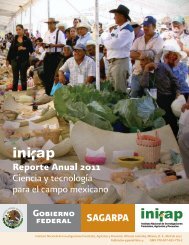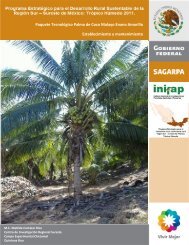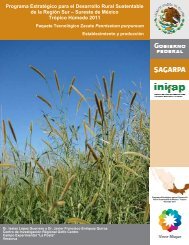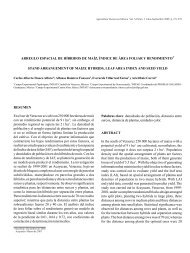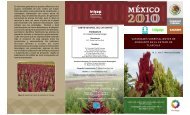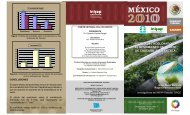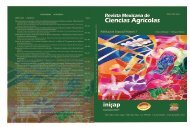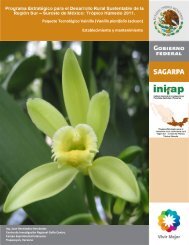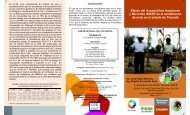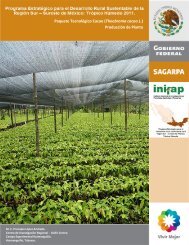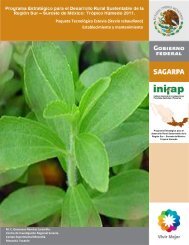Vol. 2 Núm. 8 - Instituto Nacional de Investigaciones Forestales ...
Vol. 2 Núm. 8 - Instituto Nacional de Investigaciones Forestales ...
Vol. 2 Núm. 8 - Instituto Nacional de Investigaciones Forestales ...
- No tags were found...
You also want an ePaper? Increase the reach of your titles
YUMPU automatically turns print PDFs into web optimized ePapers that Google loves.
Rev. Mex. Cien. For. <strong>Vol</strong>. 2 Núm. 8INTRODUCCIÓNPara la propagación <strong>de</strong> especies forestales en vivero, senecesita contar con información que permita ubicar, dimensionare implementar las acciones contenidas en los planes <strong>de</strong>trabajo que posibiliten el cumplimiento <strong>de</strong> los objetivos y metasplanteados. In<strong>de</strong>pendientemente <strong>de</strong>l tipo <strong>de</strong> germoplasmaa propagar, una <strong>de</strong> las principales <strong>de</strong>cisiones <strong>de</strong>l viverista esla <strong>de</strong>terminación <strong>de</strong>l tipo <strong>de</strong>l envase o contenedor a emplear,el cual se elegirá en función <strong>de</strong> la especie a propagar, asímismo <strong>de</strong>berán consi<strong>de</strong>rarse algunas características <strong>de</strong> tipobiológico y económico (Mexal et al.,1993). Las primeras incluyenel tamaño <strong>de</strong> la semilla o estaquilla, la altura final <strong>de</strong> la plántulay su calidad, así como, las condiciones ambientales <strong>de</strong>l lugar<strong>de</strong>finitivo <strong>de</strong> la plantación. Des<strong>de</strong> el punto <strong>de</strong> vista económico,se tomaran en cuenta el costo, la capacidad, posibilidad <strong>de</strong>reuso, disponibilidad en el mercado, <strong>de</strong>nsidad <strong>de</strong> plantas porunidad <strong>de</strong> superficie, facilidad <strong>de</strong> llenado, manejo y transporte(Fisher, 1992; Landis et al., 1994; Ruano, 2002; Toral et al.,2000). También son importantes el tipo y tamaño <strong>de</strong> envase, yaque si las plantas crecen muy juntas y se entrelaza su follaje sonmás susceptibles a daños por plagas o enfermeda<strong>de</strong>s. Esto sepue<strong>de</strong> solucionar si se conoce el hábito <strong>de</strong> crecimiento <strong>de</strong> cadauna <strong>de</strong> las especies, con la finalidad <strong>de</strong> manejar la <strong>de</strong>nsidadóptima, la cual inci<strong>de</strong> en la lignificación <strong>de</strong> los tallos (Landis etal., 1994; Peterson y Sutherland, 1989; Timmis y Tanaka, 1976).El tipo y tamaño <strong>de</strong>l contenedor tiene relación directa conla morfología radical y el <strong>de</strong>sarrollo aéreo <strong>de</strong> las plantasen vivero, esta, a su vez influye enormemente en el éxito <strong>de</strong> laplantación (Bur<strong>de</strong>tt et al., 1983; Landis et al.,1994; Ritchie, 1984;Wenny et al., 1988;); por lo tanto los viveristas se asegurarán<strong>de</strong> emplear el tipo <strong>de</strong> contenedor apropiado, en cuanto a diseño,capacidad, espacio entre celdas, durabilidad, costo, dificultad <strong>de</strong>manejo en el vivero, transporte y operación <strong>de</strong> la plantación.A<strong>de</strong>más, se integrarán, en la toma <strong>de</strong> <strong>de</strong>cisiones, <strong>de</strong> acuerdoa su <strong>de</strong>stino final: plantaciones forestales <strong>de</strong> conservacióno comerciales (Fisher, 1992).Las propieda<strong>de</strong>s <strong>de</strong>l contenedor i<strong>de</strong>al se han investigado<strong>de</strong>s<strong>de</strong> la década <strong>de</strong> 1930 en Estados Unidos <strong>de</strong> América(Strachan, 1974) y aunque pue<strong>de</strong>n ser comparados en distintasformas, la más apropiada es en relación a su funcionalidad.La función primaria <strong>de</strong> cualquier envase es la <strong>de</strong> conteneruna cantidad <strong>de</strong> sustrato, que abastece a las raíces connutrimentos minerales y provee soporte físico a la plantamientras está en el vivero (Mexal et al., 1993). El contenedori<strong>de</strong>al es el que permite obtener la mejor calidad <strong>de</strong> plantas, enel menor tiempo posible (Liegel y Venator, 1987).En Estados Unidos <strong>de</strong> América, los contenedores <strong>de</strong> mayoruso en los viveros son <strong>de</strong> poliestireno comprimido (51%<strong>de</strong>l total nacional), plástico rígido 26%, tipo libro o fundaINTRODUCTIONIn or<strong>de</strong>r to propagate forest species at the nursery it is necessaryto have the information that allows to locate, measure andimplement the actions in work-plans that make it possible toaccomplish the consi<strong>de</strong>red aims and goals. Regardless of the kindof germ plasm that will be propagated, one of the most important<strong>de</strong>cisions that the nursery-man will make is to <strong>de</strong>termine thekind of container to use, which will be selected according tothe species to be handled, as well as some biological an<strong>de</strong>conomic elements (Mexal et al., 1993). The first inclu<strong>de</strong> thesize of the seed or cutting, the final height of the seedling andtheir quality, as well as the environmental conditions of the finalplantation place. From the economic viewpoint, costs, capacity,reuse possibility, market availability, plant <strong>de</strong>nsity per area, fillingpossibilities, handling and transportation (Fisher, 1992; Landiset al., 1994; Ruano, 2002; Toral et al., 2000). The kind andsize of the container are important too, since if the plants growvery close to each other and their foliage mixes between them,they are more vulnerable to damages caused by plagues anddiseases. This can be solved if the growth habits of each of thespecies are known, in or<strong>de</strong>r to manage the optimal <strong>de</strong>nsity, whichaffects the lignifications of stems (Landis et al., 1994; Peterson andSutherland, 1989; Timmis and Tanaka, 1976).The kind and size of the container has a direct relation withroot morphology and the aerial <strong>de</strong>velopment of plants in thenursery, which affects enormously the success of the plantation(Bur<strong>de</strong>tt et al., 1983; Landis et al., 1994; Ritchie, 1984; Wennyet al., 1988), as well; thus, the nursery workers will make sureto use the right type of container in terms of <strong>de</strong>sign, capacity,space between cells, durability, cost, management difficulty atthe nursery, transportation and operation of the plantation. Inaddition, they will be taken into account for <strong>de</strong>cision making(Fisher, 1992), in regard to their final <strong>de</strong>stination, commercialforest plantations or conservation.The properties of the i<strong>de</strong>al container have been investigatedsince the 1930’s in the United States of America (Strachan, 1974)and in spite of being compared in many different ways, themost suitable consi<strong>de</strong>rs its functional qualities.The basic function of any container is to keep some amountof substrate, which provi<strong>de</strong>s mineral nutrients to roots andprovi<strong>de</strong>s physical support to the plant while it is in the nursery(Mexal et al., 1993). The i<strong>de</strong>al container favors to get the bestquality of plants in the least time (Liegel and Venator, 1987).In the United States of America, the most regularly usedcontainers at the nursery are ma<strong>de</strong> of compressed polystyrene(51% of the total at national scale), 26% rigid plastic, 10% bookor dustjacket type, 10% paper and 3% of different kind(Landis et al., 1994). Those of polystyrene, once their life span hasen<strong>de</strong>d, become pollutant and those of rigid or flexible plastic22



